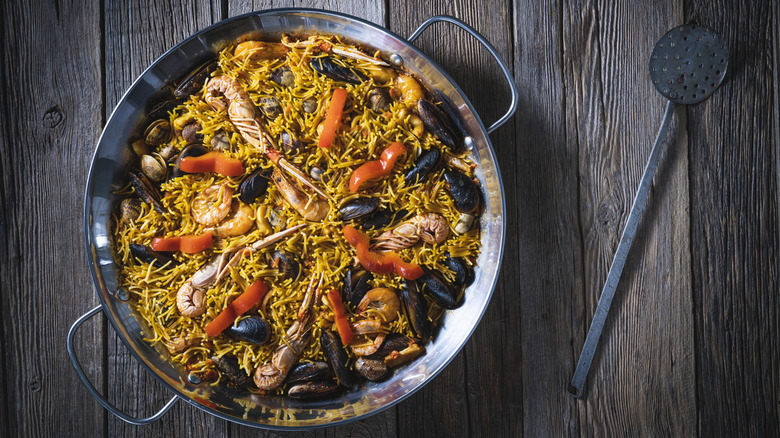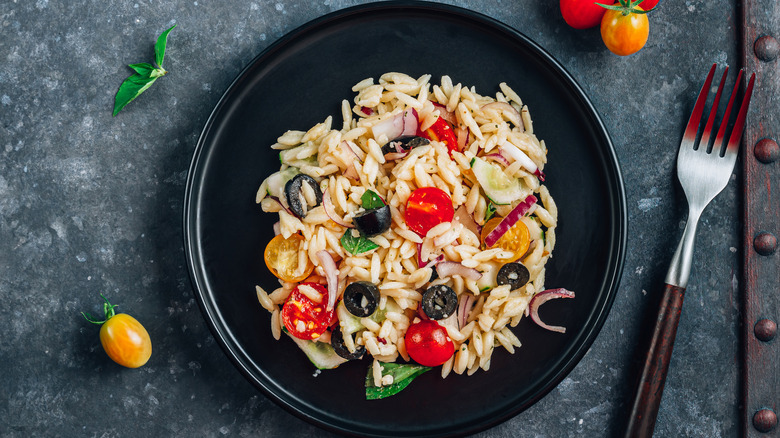Is Orzo Considered Rice Or Pasta?
If you're a little confused about orzo, don't worry, this is a judgment-free space. We can safely admit here that it's one of the more confusing starches, given that it's often stocked beside pasta but looks a lot more like rice. Heck, your grocery store might even throw them all into the same section.
Even if you've eaten orzo before, you could be forgiven for mistaking it for rice. Pieces of orzo are roughly the same size and shape as some common kinds of rice, like jasmine. Even though wheat pasta and rice have distinct flavors, both are subtle and can easily get lost in a saucy, flavorful dish. There's a reason swapping rice for orzo in risotto is one of the sabotages Gordon Ramsay throws at his Hell's Kitchen contestants to test their attention to detail.
But, to answer your question once and for all, orzo is not a type of rice. Orzo is a shape of pasta, just like spaghetti or ziti, and is typically made from wheat flour. Rice, of course, is a whole different plant. Depending on the recipe, you might be able to swap orzo for rice in a pinch, or vice versa, but the two are distinct and definitely not interchangeable.
Rice, rice baby
The only difference between orzo and any other pasta is simply the size and shape. It's just a tiny pasta, which actually has a name in Italian: pastina. Ironically, the word "orzo" means "barley" in Italian — a different grain entirely. Orzo is cooked in more or less the same way as all pasta: by bringing water to a boil, adding the orzo, and letting it cook for 8-10 minutes or until it's al dente.
Rice, on the other hand, is itself a grain. There are many different varieties of rice (literally thousands), such as jasmine, arborio, brown, wild, and sushi rice. Specific preparation instructions will differ based on the recipe and type of rice but, on the whole, rice takes considerably longer to cook than pasta — in the ballpark of 15-20 minutes for white rice, and easily twice that for tougher, whole-grain varieties.
Nutritionally, orzo contains more calories and carbohydrates than the same serving size of long-grain white rice. Orzo, however, offers more protein and fiber per serving, and since most common grocery store brand pastas are enriched with micronutrients, they'll often provide significant quantities of folate, niacin, and thiamine. Importantly, orzo contains gluten and rice does not, so those with Celiac Disease need to steer clear unless they can find gluten-free orzo.
Stop and swap
There are also differences in how orzo and rice are each used in cooking. You wouldn't typically serve orzo plain as a side like you do with rice. The most common orzo recipes treat it more or less like you would any other pasta — fully incorporated mixes of pasta, sauce, veggies, cheese, and whatnot, making up either a hot bowl of pasta or a cold pasta salad. If you're trying to alter this type of orzo recipe to make it gluten-free, you could theoretically sub rice in. Just note that it'll have the chewier texture of rice rather than the soft, smooth bite of pasta.
Many rice dishes simply wouldn't work with orzo. Any kind of rice ball, like arancini or onigiri, needs rice's higher starch content in order to stick together. Soups, stews, and other mixed dishes are likely the easiest kinds of recipes to swap orzo for rice, or vice versa — just be mindful of the significantly different cook times so your orzo doesn't get mushy or your rice doesn't stay hard.


